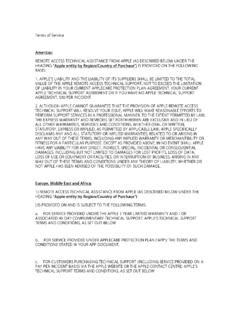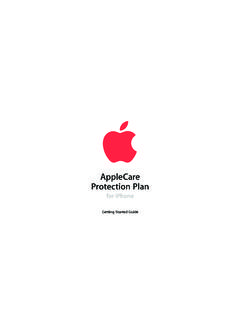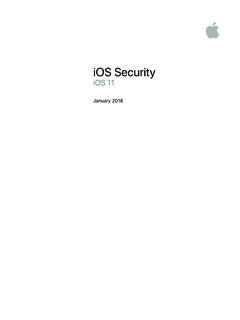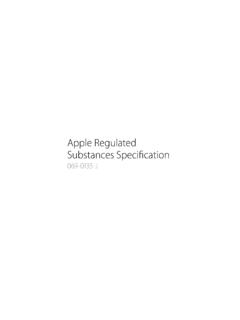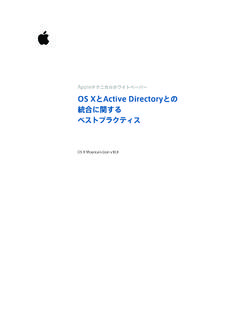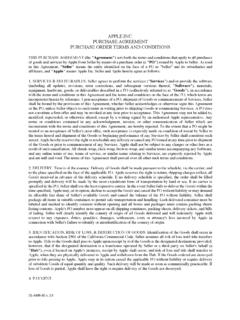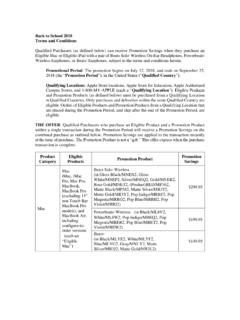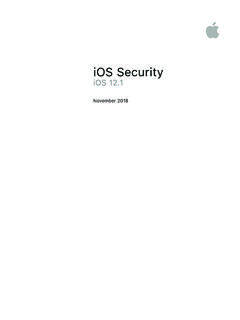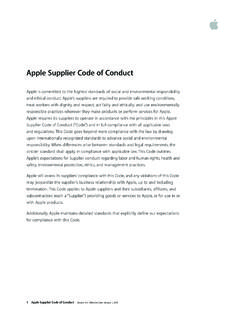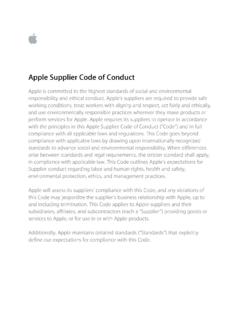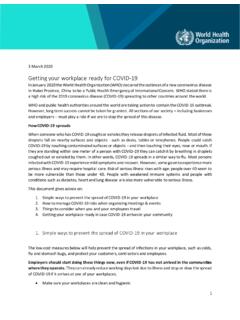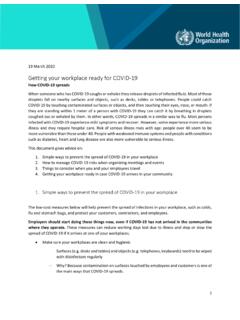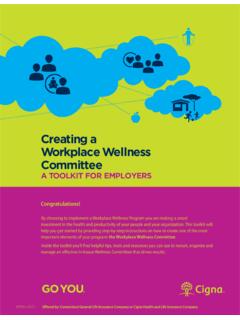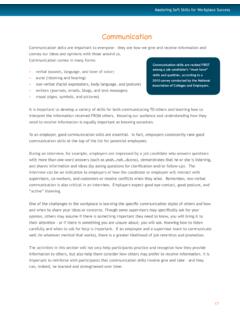Transcription of Apple Lifecycle Management
1 Apple Lifecycle Management IntroductionIntroduction All types of businesses all over the world are reinventing themselves with mobility. Industries like aviation, law enforcement, and healthcare use Apple devices and apps to carry out essential business tasks. As mobility becomes even more important to the workplace, businesses need to make sure that they re investing in secure platforms and establishing processes to keep those platforms up to date. To sustain this level of stability, businesses are embracing a modern approach to testing and updating software that s proactive, nimble, and perpetual. Moving quickly and continually with software updates creates significant advantages that can keep the enterprise environment a step ahead of emerging security concerns and ensure the highest level of platform integrity.
2 This helps businesses minimize downtime and compatibility issues, better serve customers, and enable employees to have the best user experience. With macOS, iOS, and iPadOS, it s easy and intuitive for your users to update their devices. With just a tap, they can download and install the latest version of Apple s operating systems. You can also schedule software updates on supervised devices using your mobile device Management (MDM) solution. But before you prompt your users to upgrade, it s critical to test each beta version because your technology ecosystem has unique requirements. And just as important as testing each beta release, key elements in your environment your IT infrastructure, third-party MDM solution, and business-critical apps must be ready when a new version is publicly released to your users.
3 The Apple platform adoption Lifecycle includes four ongoing activities for each time a beta is released: preparing your environment, evaluating key areas of Apple s platforms, submitting feedback, and getting ready for your rollout. When you implement a modern approach to Lifecycle Management , not only can you be confident when employees update, but you ll also enjoy enhanced data security, improved productivity, maximum uptime, and greater employee satisfaction. This document is intended to help your IT organization understand the benefits of implementing Apple Lifecycle Management , consider all the elements that go into managing this process, and establish a clear and repeatable process to ensure that you re ready to stay up to date with the latest software from Apple .
4 Apple Lifecycle Management March 2020 2 Contents Introduction Modern Lifecycle Management Preparing your environment Evaluating Apple s platforms Submitting feedback getting ready for your rollout Summary Ultimately, protecting our customer and employee experience is of utmost importance and worth the investment of a rigorous testing process. Jennifer Paine Senior Director Employee Mobility Southwest AirlinesModern Lifecycle managementModern Lifecycle Management Deploying software updates is critical to maintaining the security and integrity of Apple s platforms. Not only does this keep your environment secure, but it allows users to benefit from and enjoy the latest features and security fixes. So it s important for your organization to evaluate all the key areas that work together in your mobile environment, all year long, so you re ready to deploy each release on the first day that it s publicly available.
5 Southwest Airlines understands the value of taking this approach with its enterprise mobile testing program. Jennifer Paine, Senior Director of Employee Mobility, describes how taking a modern approach is critical: Adopting the Apple platform Lifecycle in a modern way means embracing the following principles: Updating software requires an iterative approach Because of changes in the software landscape, you can no longer delay upgrading your software indefinitely because systems have worked just fine in the past. Instead, organizations are taking a more proactive approach of updating their Apple platforms multiple times a year to stay current. Apple delivers software updates to keep your devices safe and your existing hardware optimized. macOS, iOS, and iPadOS were developed to make it easy and intuitive for users to set up themselves and update their devices.
6 Enterprises no longer need huge service operations and system imaging processes to make upgrades. Multiple generations of Apple products can benefit from updates that protect your platform from security vulnerabilities and offer enhanced productivity features. Apple Lifecycle Management March 2020 3 Our pilots and flight attendants depend on iPad devices for critical job functions. We can t risk having an update cause a problem with the iPad. Ultimately, protecting our customer and employee experience is of utmost importance and worth the investment of a rigorous testing process. iOS 13iOS 12 Earlier Release77% of iPhone devices introduced in the last 4 years use iOS measured by the App Store on January 27, 12 Earlier Release79% of iPad devices introduced in the last 4 years use measured by the App Store on January 27, Lifecycle managementTesting is a year-round effort Take note of the Apple beta release time frames so you can evaluate each release throughout the year and prepare for any changes that might come up.
7 Whether the release is a major version or a dot release, it s important for users and IT support teams to test and deploy all updates to maximize security and compatibility. Below is an example of iOS release time frames. Everything in your mobile environment is interdependent macOS, iOS, and iPadOS can integrate with just about any IT environment from network infrastructure to service integration so you can use Apple devices seamlessly within your environment. Apple software updates can affect the way these services interact with the operating systems and, therefore, impact how Apple devices operate. For that reason, it s important to continue testing upgrades not only on users devices, but within your larger network ecosystem as a whole. Adopting a modern Lifecycle for Apple s platforms involves the following areas: preparing your environment, evaluating key areas of the Apple platforms, submitting feedback, and getting ready for your rollout.
8 Apple Lifecycle Management March 2020 4IT systemsMDM solutionBusiness appsPreparing your environmentPreparing your environment Establishing a program for managing Apple s platforms involves a few simple steps. First, you ll want to select team members who can be dedicated to your initiative and train them. Second, enroll in the AppleSeed for IT program to get access to prerelease software so you can begin the evaluation process. Finally, establish a device refresh process that includes financing, provisioning devices, and offering the right support. Assemble teams to support your initiative Having teams prepared and in place will help you uncover and address potential compatibility issues quickly. Organize a dedicated team focused on evaluating the key areas of Apple s platforms, and form smaller teams of volunteers that represent all your business groups.
9 Set up a dedicated team Many businesses have seen the value of adding a dedicated team to their enterprise mobile testing programs to evaluate Apple s platforms. Start by assembling a small group of testers who can devote time to evaluating how macOS, iOS, and iPadOS interact with core business resources, including your MDM solution, Exchange, your network infrastructure, and critical corporate apps. Identify internal talent with software testing or QA experience that could be applied to this role, so they can become part of your existing IT teams. You can also outsource testing to a third party. Get cross-functional groups to participate You ll also want to identify employee volunteers who can provide functional expertise in each of your business groups. For example, an airline company may have several business groups, such as ground crew, ticketing, technicians, flight operations, and training.
10 Including each of your business groups helps ensure that you re testing all scenarios and getting the right feedback in the field. There s no replacement for using your actual environment to test your devices. Group leaders. Identify key individuals to serve as group leaders for each functional/business group. Group leaders will gather input and communicate results to your dedicated team. Candidates should have an interest in beta testing and be comfortable managing team members workflows. Team members. To build the team, select employees who use Apple devices in their day-to-day roles. The size of each team should be proportional to the overall size of its functional business group. Apple Lifecycle Management March 2020 5 RolloutSubmitEvaluatePrepareiOSThe Apple platform adoption Lifecycle consists of four phases: prepare, evaluate, submit, and your environmentAs you recruit cross-functional leaders and team members, consider: How do they use Apple devices and apps in their role?
